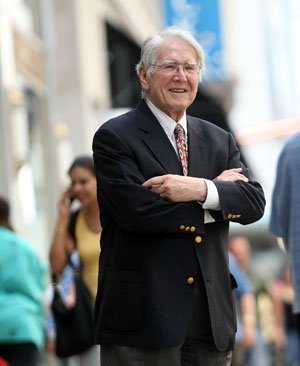America Un-Covered
With 47 million uninsured, how does this nation care for its people?
by Cheryl SooHoo
Ward Rounds
Northwestern University Feinberg School of Medicine
Summer 2008, Volume 25, Number 2
(Excerpts)

Dr. Quentin Young, PNHP National Coordinator
In the April 1 issue of the Annals of Internal Medicine, two physician researchers from Indiana University revealed results from their 2007 survey of physicians whom they queried on the subject of government-organized national health insurance (NHI). A follow up to a 2002 survey, the new poll indicated that a larger percentage of doctors—59 versus 49 percent five years ago—supported health care reform to achieve greater coverage for individuals living in the United States. Numerous media outlets reported on the survey’s results, prompting the American Medical Association (AMA), among others, to weigh in on the universal health care discussion. …
… For recently retired internist Quentin D. Young, MD ‘48, championing the creation of a singlepayer NHI plan that would expand the existing Medicare model and essentially eliminate private insurance has led to conversations with members of Congress, including Senator Barack Obama (D-Ill.), the Democratic Party’s presumptive nominee for the highest office in the land.
“We’ve talked, because I wanted to know what his views were on the single-payer proposal. In fact, I’ve known Obama for a long time. He sees a colleague physician in my Hyde Park practice,” shares Dr. Young, national coordinator of Chicago-based Physicians for a National Health Program (PNHP). And what does Dr. Young think of Congressman Obama’s health care platform? “In my opinion it’s bad because it maintains employer-based private insurance! Although he no longer does, Obama did support singlepayer in the past.”
With some 15,000 members, PNHP describes itself as a physicians group that believes all people have a right to access high-quality comprehensive care. Achieving that particular vision begins with educating physicians on the need for a single-payer NHI plan, through vehicles the medical profession finds credible such as peer-reviewed journals and grand rounds lectures.
“Doctors by definitrd. “Many consider them the most knowledgeable elements in the equation and, not least, they have earned inion are involved in the health system,” remarks Dr. Young, the 2008 recipient of the Feinberg School’s Distinguished Alumni Awafluence as discussants on health issues.”
One “scholarly” coup for the group and others was an article that appeared in the August 2003 issue of the Journal of the American Medical Association. In that piece, the Physicians’ Working Group for Single-Payer National Health Insurance, which included faculty members from Harvard University as well as Dr. Young, a faculty member at the University of Illinois and former chair of internal medicine at Cook County Hospital, methodically laid out their NHI proposal.
Administered by a single public agency that organizes health financing but leaves the delivery of care largely private, NHI would feature universal, comprehensive coverage and a free choice of providers. The plan backed by PNHP would call for physicians to receive fee-for-service payments dictated by a negotiated formulary or draw salaries from hospitals or nonprofit HMO/group practices. A global budget would take care of each hospital’s operating costs. Financing for the system would come from taxes and bidding adieu to private insurers. Recapturing the administrative “waste” of large corporations currently managing the mosaic of health plans available in the United States would more than pay for NHI as evidenced by a current U.S. government program, believes Dr. Young.
“America already has singlepayer national health insurance. It’s called ‘Medicare,’” he explains. “Medicare is the most successful program in the country, outshining any of the private sector insurance companies with their high administrative costs. Thirty-one percent of all health care dollars now go to absorbing the administrative costs of the big carriers. Medicare has an administrative cost of 3 percent. When you are dealing with a system where every percentage point is 21 billion dollars, the costs are fairly significant.”
PNHP has faced many critics, from those who consider the group’s plan tantamount to “socialized” medicine to those who fear rationing of health care services. And using the Medicare program as a model raises its own serious financial issues as Medicare’s hospital insurance trust fund, on its present course, is expected to run out of money in 2019, according to a report from the Board of Trustees for Medicare released this March.
Yet octogenarian Dr. Young remains optimistic. His enthusiasm for NHI continues to be bolstered by growing legislative support for House Resolution (H.R.) 676—the “Expanded and Improved Medicare for All Act.” Rep. John Conyers (D-Mich.) first introduced the bill in 2005, after inviting Dr. Young and other NHI proponents to Washington to present their proposal for possible legislation. Additionally, Dr. Young’s observation that “American doctors have learned that there is something worse than government, and it is called corporations” has him convinced that PNHP’s vision finally is reaching the mainstream.
“Until quite recently, we were considered irrelevant because we were unfeasible,” he says. “That’s over now. There have been enough victories and public discussion so that we have become the ‘undesirable’ alternative. Doesn’t sound like much, but that’s upward mobility!”



